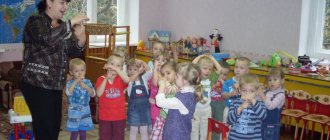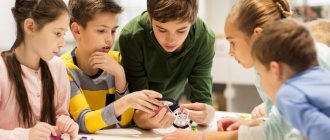Health-saving technologies in the teaching and educational process of primary school
“The hand is the brain coming out,” this statement of Immanuel Kant was made even before the physiological significance of the development of fine motor skills was proven. Man is a universal “thinking body”; a classic example of this universality is the moving hand of man. The greatest impact of impulses from the arm muscles on the development of the cerebral cortex occurs only in childhood, while the motor area is being formed. Therefore, work on developing fine motor skills of the fingers at primary school age is of particular importance.
Working on the development of fine motor skills of the fingers, we solve the following problems:
stimulation of speech development in young children;
preparing the hand for writing in younger schoolchildren;
attention training;
coordination of movements;
adaptation of little left-handers in a world of right-handers.
We carry out a set of gymnastics exercises for fingers for 6-8 minutes. It includes 6-8 exercises performed in the following sequence:
fingertips;
Hands;
forearm;
shoulder.
As you get used to the complex, new exercises are included in it or the conditions for performing previously learned exercises become more complicated.
There are many sets of exercises for fingers. (Appendix 6)
I also do self-massage
fingers, neck, shoulders, head. (Appendix 7)
In my lessons I pay a lot of attention to eye exercises.
since there are children in the class who periodically experience a decrease in visual acuity and there are children who have disease of the eye or its adnexal apparatus.
In the class there is an ophthalmological simulator developed by Professor Bazarny. Bazarny's method involves moving students' gaze along trajectories. Exercises are performed at the teacher’s command and only while standing. In accordance with the instructions of the arrows, the student’s gaze moves along a trajectory: right-left, up-down, clockwise and counterclockwise, in a figure eight.
Objectives of eye gymnastics:
promote a healing effect in the process of using the proposed exercises;
prevent visual fatigue in schoolchildren.
We carry out a set of gymnastics exercises for the eyes for 3-5 minutes. It includes up to 5 exercises:
massage exercises;
rubbing;
relieving visual tension;
attention exercises.
As we get used to the complex, we include new exercises in it or the conditions for performing previously learned exercises become more complicated.
To improve and correct vision, we do the following exercises. (Application 
perform a healing function .
Exercises for muscle relaxation must be known and applied in practice in order to be able to manage the processes of arousal in children under emotional stress, when the child experiences excessive tension in certain muscle groups. Children cannot get rid of this tension on their own; they begin to get nervous, which leads to tension in new muscle groups. To manage these processes, I try to teach children to relax their muscles, I teach them to feel muscle tension, relieve it by relaxing certain muscle groups. Muscle relaxation exercises help prevent circulatory diseases. These exercises make breathing easier and promote normal functioning of the digestive organs. Due to the inhibitory effect, muscle relaxation exercises are effective in cases of increased arousal in order to prevent neuroses and overexcitation of the nervous system. Relaxation exercises can be done in any lesson for 3-5 minutes. (Appendix 9).
Health-saving technologies: concept, purpose and objectives. article
Health-saving technologies: concept, purpose and objectives.
Before we start talking about health-saving technologies, let’s define the concept of “technology”. Technology is a tool for the professional activity of a teacher, which is accordingly characterized by a qualitative adjective – pedagogical. The essence of pedagogical technology is that it has a pronounced phasing (step-by-step), includes a set of certain professional actions at each stage, allowing the teacher to foresee the intermediate and final results of his own professional and pedagogical activities during the design process. Pedagogical technology is distinguished by: specificity and clarity of goals and objectives, the presence of stages: primary diagnosis; selection of content, forms, methods and techniques for its implementation; using a set of tools in a certain logic with the organization of intermediate diagnostics to achieve the designated goal; final diagnostics of goal achievement, criteria-based assessment of results. (This definition is proposed by Derkunskaya V.A. - Candidate of Pedagogical Sciences) What are health-saving technologies? Health-saving technologies in preschool education are technologies aimed at solving the priority task of modern preschool education - the task of preserving, maintaining and enriching the health of the subjects of the pedagogical process in kindergarten: children, teachers and parents. The goal of health-saving technologies in preschool education in relation to a child is to ensure a high level of real health for a kindergarten pupil and the education of valeological culture as the totality of a child’s conscious attitude to health and human life, knowledge about health and the ability to protect, support and preserve it, valeological competence, allowing a preschooler independently and effectively solve problems of a healthy lifestyle and safe behavior, tasks related to the provision of basic medical, psychological self-help and assistance.
The objectives of health-saving technologies are;
1. Preservation and strengthening of children’s health based on the integrated and systematic use of physical education means available to kindergartens and optimization of physical activity in the fresh air.
2. Ensuring an active position for children in the process of gaining knowledge about a healthy lifestyle.
3. Constructive partnership between the family, the teaching staff and the children themselves in strengthening their health and developing their creative potential.
Types of health-saving technologies used in preschool educational institutions
Types of health-saving technologies in preschool education - classification of health-saving technologies according to the dominance of goals and tasks to be solved, as well as the leading means of health-saving and health-enrichment of subjects of the pedagogical process in kindergarten. Health-saving activities in kindergarten are carried out in the following forms: Medical and preventive technologies. Medical and preventive activities ensure the preservation and enhancement of children’s health under the guidance of preschool medical personnel in accordance with medical requirements and standards using medical supplies. The objectives of this activity are: - organization of monitoring of children's health and development of recommendations for optimizing children's health; - organization and control of children's nutrition, physical development, hardening; - organization of preventive measures that contribute to the resistance of the child's body (for example, immunization, gentle treatment during the adaptation period, etc. .d.) - organization of control and assistance in ensuring the requirements of sanitary and epidemiological standards - San PiNov - organization of a health-preserving environment in preschool educational institutions. Monitoring of the health status and physical development of children is carried out by kindergarten medical workers. All work on the physical education of children in preschool educational institutions is based on their physical fitness and existing deviations in health. To do this, based on individual medical records, the preschool doctor draws up a summary diagram for each age group, which helps educators and medical workers have a clear picture of the health status of the children of the entire group and each child individually. This analysis scheme and specific recommendations are entered into the group “Health Log” - “Child’s Individual Route” - so that each teacher plans physical education and health activities in accordance with the children’s health characteristics.
Physical education and health technology. Physical education and health activities are aimed at the physical development and strengthening of the child’s health. The objectives of this activity are: - development of physical qualities; — control of motor activity and the development of physical education in preschool children, — formation of correct posture, prevention of disorders of the musculoskeletal system; - fostering the habit of daily physical activity; - health improvement by means of hardening. Physical education and health activities are carried out by a physical education instructor during physical education classes, as well as by teachers - in the form of various gymnastics, physical education sessions, dynamic breaks, etc.;
Technologies for ensuring the socio-psychological well-being of the child. The purpose of this activity is to ensure emotional comfort and positive psychological well-being of the child in the process of communicating with peers and adults in kindergarten and family; ensuring the social and emotional well-being of a preschooler, because emotional mood, mental well-being, cheerful mood of children is important for their health. In its activities, the “escort service” is guided by the regulations on the medical-psychological-pedagogical service and aims to create an integral system in a preschool institution that provides optimal conditions for the development of children, taking into account age and individual characteristics, the state of somatic and mental health. In this system, diagnostic, advisory, correctional and developmental, treatment and preventive and social areas interact.
Technologies for health preservation and health enrichment of teachers. Improving the health of children and their favorable physical development is influenced by the entire way of life of a child in kindergarten, the caring and attentive attitude of adults towards him, and the high sense of responsibility of the entire team for each pupil. Therefore, much attention in preschool educational institutions is paid to the selection and placement of personnel into groups, taking into account their business qualities, experience and psychological compatibility. Bearing in mind that the results of physical development depend primarily on the professional training of teachers and their pedagogical knowledge, a system of comprehensive methodological work to improve skills has been thought out. A teacher who guards the health of the child, who fosters a culture of health for the child and parents, must first of all be healthy himself, have valeological knowledge, not overworked, must be able to objectively assess his strengths and weaknesses associated with professional activities, draw up a plan for the necessary self-correction and begin its implementation.
Technologies of valeological education of parents. The main educators of the child are the parents. The child’s mood and state of physical comfort depend on how the child’s daily routine is properly organized and how much attention parents pay to the child’s health. The healthy lifestyle of a child, to which he is taught in an educational institution, can either find daily support at home, and then be consolidated, or not be found, and then the information received will be unnecessary and painful for the child. Information and educational activities are expressed in the formation of a healthy lifestyle as a value among parents, as well as in introducing parents to various forms of physical education in a preschool institution, informing about the state of health and physical development, and the level of motor readiness of their child; involving parents in participating in various joint physical education activities and holidays. In order to cooperate with parents in promoting a healthy lifestyle in children, we have developed a system of events, which include: parent meetings, consultations, competitions, sports events, health events, family clubs, moving folders, conversations, personal example of a teacher, non-traditional forms of working with parents, practical demonstrations (workshops).
Health-saving educational technologies. This type of activity involves the education of a valeological culture, or a culture of health, in preschool children. Its goal is to form in children a conscious attitude towards health and life, accumulation of knowledge about health and development of skills to protect it. Health-saving educational technologies are the most significant among all known technologies in terms of the degree of influence on children’s health. Their main feature is the use of psychological and pedagogical techniques, methods, and approaches to solving emerging problems. Educational activities involve conducting classes and conversations with preschoolers about the need to maintain a daily routine, the importance of hygienic and physical culture, about health and means of strengthening it, about the functioning of the body and the rules of caring for it, children acquire cultural and healthy lifestyle skills, knowledge of the rules of safe behavior and reasonable actions in unforeseen situations.
Preparing a child for a healthy lifestyle based on health-saving technologies should become a priority in the activities of every educational institution for preschool children.



